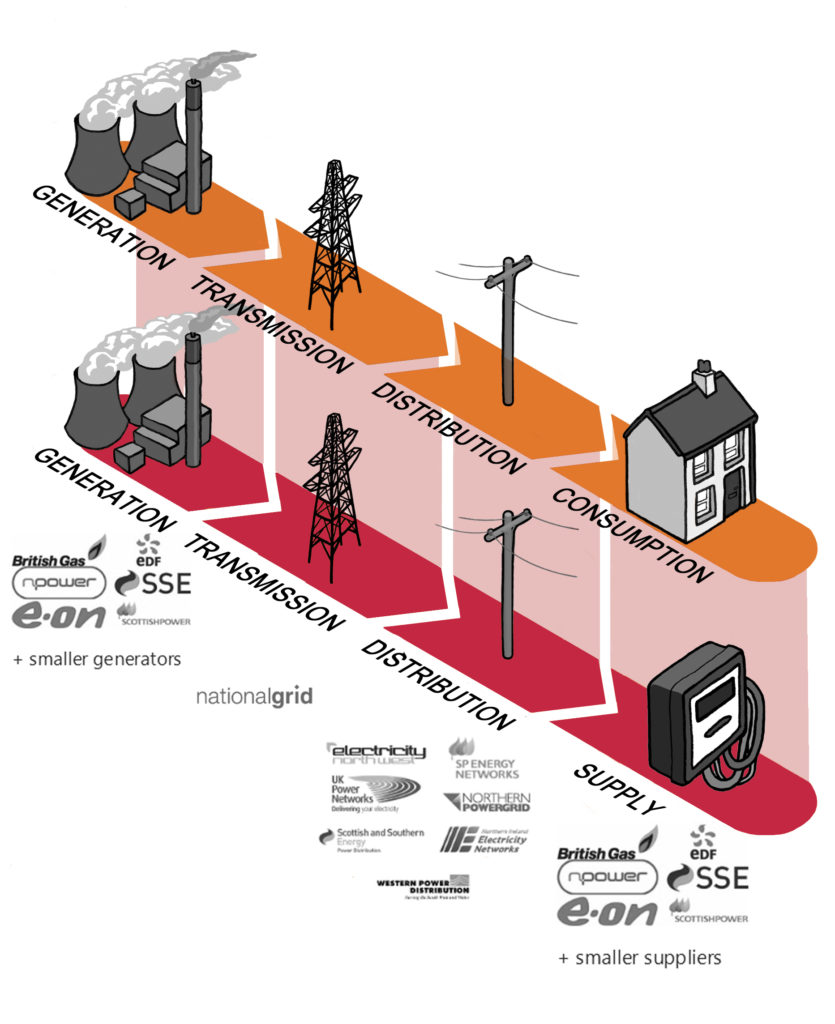There are a number of different energy system roles in the electricity and gas systems. These roles are addressed in detail in the chapters on ownership, money flows and governance and decision-making. They are described here to give an overview and definition.
Electricity

Generation
This is the generation of electricity from primary energy e.g. coal, gas, wind power, solar power.
- Power stations – nuclear, coal, gas, wind power, solar power, energy from waste etc. Anything that generates electricity from primary energy.
- Different power stations are owned by different private owners. These vary from multinational companies which own several large power stations, to households which own a few solar panels.
- Generators are paid for generating electricity. The price they receive varies depending on the time at which it is produced. Generators can sell electricity through several different routes, including through the wholesale market, through various government-regulated auctions and direct to consumers. Electricity can also be sold just before it is produced or a long time ahead.
Governance:
- Generation is a regulated licensed electricity system role. In the regulation, it is lumped together with storage (i.e. storage is categorised as a form of generation, for licensing purposes).
Storage
- Electricity storage – e.g. pumped storage, batteries, flywheels. As storage of electricity actually involves conversion to another form of energy, this is a point of potential intersection between different parts of the energy system (e.g. electricity, heat, gas)
- Storage is owned by many different private owners. Some are big energy companies, others are startups, and some are community energy organisations.
- Storage operators are paid through various contracts based on being available to store or release energy, and actually doing so.
Governance:
- Storage is categorised as a form of ‘generation’ within the electricity system licensing and regulatory regime.
Transmission
This is the high voltage national network of cables and pylons which takes electricity from power stations to towns and cities where it is needed. It was built in the 1930s. Some of the energy travelling in these cables is lost as heat. Some large industrial consumers are connected directly to the transmission network.
- High voltage transmission network.
- The transmission network is a natural monopoly with a single private owner in England and Wales and a single private owner in Scotland.
- The transmission network receives money from supply companies, which ultimately comes from bills. This is allocated through a regulatory process that dictates how much income they should receive.
Governance:
- Transmission is a regulated licensed activity in the energy system.
Distribution
This is the low voltage regional network of cables and pylons which takes electricity from the transmission network to industry, homes and offices, where it is used. The electricity is gradually ‘stepped down’ from high to low voltages in transformers at substations.
Physical infrastructure:
- Low voltage cables and pylons
- The distribution network is a natural monopoly with regional private owners
Money flows:
- The distribution network receives money from supply companies, which ultimately comes from bills. This is allocated through a regulatory process that dictates how much income they should receive. [more – link to money flows chapter for detail]
Governance:
- Distribution is a regulated licensed activity in the energy system.
Supply
This is the retail of electricity to consumers. The amount consumed is measured by a meter.
- Supply is a competitive market which has historically been dominated by six large companies that inherited customers during privatisation. Smaller energy supply companies have entered the market and started to take market share. [more – link to organisations and ownership chapter for detail]
- This is the part of the energy system which most people interact with, as the suppliers send consumers bills. Bills paid by consumers to suppliers are then allocated to various parts of the energy system, including paying for the physical infrastructure and primary energy in generation, transmission and distribution, paying for administrative processes in all parts of the system, and profits to investors. Some of this money also goes to innovation.
Governance:
- Supply is a regulated licensed activity in the energy system. In GB, this licensed activity includes both retail and balancing and settlement (see below)
Flexibility
Flexibility is an important physical infrastructure issue.
- text about flexibility in physical infrastructure
- Text about flexiblity in ownership
Money Flows:
https://www.regen.co.uk/wp-content/uploads/Regen_Local-flexibility-guide.pdf – this needs to be here. And inside the book itself. But here too.
Wholesale market operation
Balancing and settlement
Balancing is a physical role, settlement is a money flows role
Regulation
Ofgem. But more complicated.
Gas
Shipping
Transmission
Distribution
Supply
Wholesale market operation??
Balancing and settlement??
Balancing is a physical role, settlement is a money flows role